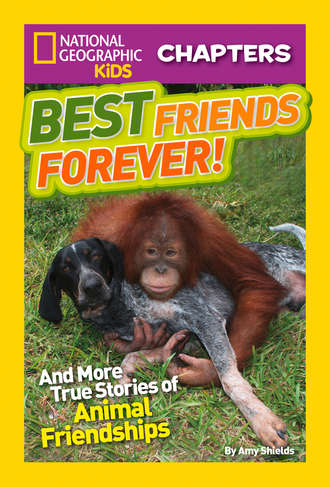
Полная версия
National Geographic Kids Chapters: Best Friends Forever: And More True Stories of Animal Friendships

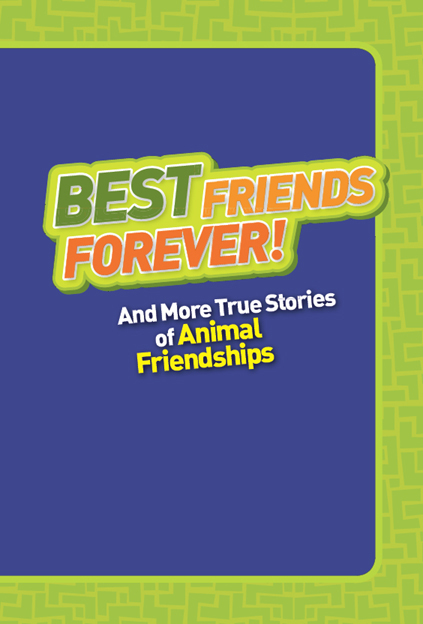
Copyright © 2013 National Geographic Society
All rights reserved. Reproduction of the whole or any part of the contents without written permission from the publisher is prohibited.
Published by the National Geographic Society
John M. Fahey, Chairman of the Board and Chief Executive Officer
Declan Moore, Executive Vice President; President, Publishing and Travel
Melina Gerosa Bellows, Executive Vice President; Chief Creative Officer, Books, Kids, and Family
Prepared by the Book Division
Hector Sierra, Senior Vice President and General Manager
Nancy Laties Feresten, Senior Vice President, Kids Publishing and Media
Jonathan Halling, Design Director, Books and Children’s Publishing
Jay Sumner, Director of Photography, Children’s Publishing
Jennifer Emmett, Vice President, Editorial Director, Children’s Books
Eva Absher-Schantz, Design Director, Kids Publishing and Media
R. Gary Colbert, Production Director
Jennifer A. Thornton, Director of Managing Editorial
Staff for This Book
Marfé Ferguson Delano, Project Editor
Becky Baines, Editor
Lisa Jewell, Illustrations Editor
David Seager, Art Director
Ruthie Thompson, Designer
Grace Hill and Michael O’Connor, Associate Managing Editors
Joan Gossett, Production Editor
Lewis R. Bassford, Production Manager
Susan Borke, Legal and Business Affairs
Ariane Szu-Tu, Editorial Assistant
Callie Broaddus, Design Production Assistant
Hillary Moloney, Illustrations Assistant
Manufacturing and Quality Management
Phillip L. Schlosser, Senior Vice President
Chris Brown, Vice President, NG Book Manufacturing
George Bounelis, Vice President, Production Services
Nicole Elliott, Manager
Rachel Faulise, Manager
Robert L. Barr, Manager

The National Geographic Society is one of the world’s largest nonprofit scientific and educational organizations. Founded in 1888 to “increase and diffuse geographic knowledge,” the Society’s mission is to inspire people to care about the planet. It reaches more than 400 million people worldwide each month through its official journal, National Geographic, and other magazines; National Geographic Channel; television documentaries; music; radio; films; books; DVDs; maps; exhibitions; live events; school publishing programs; interactive media; and merchandise. National Geographic has funded more than 10,000 scientific research, conservation, and exploration projects and supports an education program promoting geographic literacy.
For more information, please visit
www.nationalgeographic.com, call 1-800-NGS LINE (647-5463), or write to the following address: National Geographic Society 1145 17th Street N.W. Washington, D.C. 20036-4688 U.S.A.
Visit us online at
www.nationalgeographic.com/books
For librarians and teachers:
www.ngchildrensbooks.org
More for kids from National Geographic:
kids.nationalgeographic.com
For rights or permissions inquiries, please contact National Geographic Books Subsidiary Rights: ngbookrights@ngs.org
eISBN: 978-1-4263-0958-8
v3.1
Version: 2017-07-06
CONTENTS
Cover
Title Page
Copyright
ROSCOE AND SURYIA: Best Friends Forever
Chapter 1: The Best Day Ever
Chapter 2: Ambassador Suryia
Chapter 3: Swim Buddies
KOKO: Crazy for Cats!
Chapter 1: Worst Present Ever
Chapter 2: A Kitten to Love
Chapter 3: Sorry, Koko Love Good
JASMINE: Super-Friend!
Chapter 1: Learning to Trust
Chapter 2: A Fawn in Need
Chapter 3: One of a Kind
OWEN AND MZEE: Odd Couple
Chapter 1: Little Lost Hippo
Chapter 2: A New Friend
Chapter 3: Happy Hippos
DON’T MISS!
More Information
Dedication
Credits
Acknowledgments
ROSCOE AND SURYIA: BEST FRIENDS FOREVER
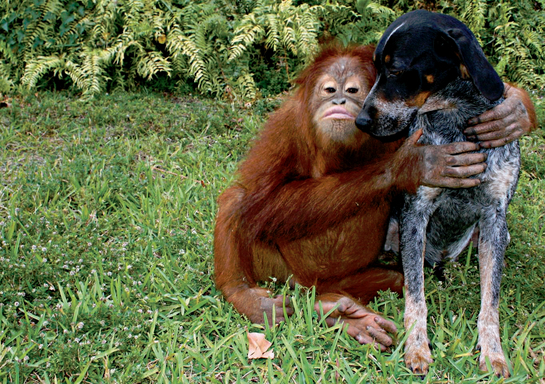
It was love at first sight when Suryia the orangutan met this dog named Roscoe.

Bubbles gives a lift to Suryia, Roscoe, and animal trainer Moksha Bybee.
Chapter 1
The BEST
DAY Ever
Summer 2008, Myrtle Beach, South Carolina
It was a muggy, hot day. An elephant named Bubbles strolled through the woods. On her back bounced a fuzzy-haired orangutan named Suryia (sounds like SUR-ee-uh). Bubbles and Suryia were excited. They knew there was a river at the end of the path. Soon they were going to be in that river. They were going for a swim!
A man named Doc walked beside Bubbles and Suryia. Looking ahead, he saw a hound dog. It sat alone on the riverbank. It looked like a hungry dog. It was so skinny you could see its ribs. Just then, Suryia spied the dog, too. Before Doc could stop him, the playful ape jumped off Bubbles.

Suryia ran to the dog. He threw his long, hairy arms around it. Uh-oh, thought Doc. A hungry dog might be a mean dog. But the dog didn’t mind a big, hairy hug. He even wagged his tail. Then he pounced at Suryia. The seven-year-old orangutan pounced back. That was their I-like-you, do-you-like-me? moment. The answer was yes!
The new pals chased each other in circles. Then they flopped down to rest. The orangutan put his arm around the dog. He pulled him close. They acted “like long lost friends,” Doc said.
After a while it was time to leave. Doc lifted Suryia back onto Bubbles. He tried to send the dog back to its own home.
But the dog followed them. He wagged his tail all the way. Wherever Suryia was, that’s where the dog wanted to be. “I guess you’ve decided to stay,” said Doc. He named the dog Roscoe.
Doc is Dr. Bhagavan Antle (sounds like BAG-uh-vahn ANN-tuhl). He is the director of a wildlife preserve in Myrtle Beach, South Carolina. Suryia and Bubbles are just two of the animals that live there.
Doc and the other caregivers at the preserve also look after lions and tigers. They care for leopards and cheetahs. They watch over monkeys, chimpanzees, and other orangutans like Suryia. There’s even a liger (sounds like LIE-ger) named Hercules at the preserve. A liger is the cub of a lion father and a tiger mother.
Now Doc had a new animal to take care of, and Suryia had a new best friend.
Roscoe is a bluetick coonhound. Blueticks are smart and friendly. They really like to hunt. Blueticks keep their noses to the ground, sniffing for clues. They forget everything except Find it, find it!
Island Homes
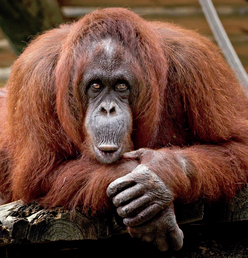
Orangutans used to live everywhere in Asia. Today they live in the wild on only two small islands. These are Sumatra (sounds like sue-MAH-tra) and Borneo (sounds like BORE-nee-oh).
Wild orangutans make their homes in rain forests. Farmers and loggers are cutting down the forests on these islands. They want to make palm tree farms. This leaves orangutans with even fewer places to live. It is harder for them to find food. Unless their forest homes are protected, there will soon be no more wild orangutans.
A bluetick coonhound won’t stop until it catches its prey or chases it up a tree.
Roscoe might have been hunting the day he met Suryia. Maybe he went too far. Maybe he could not find his way back home. Maybe he did not have a home.
At first, Doc kept a careful eye on Suryia and Roscoe. Animals often get scared when something new enters their world. Suryia had never been face-to-face with a dog before. Had Roscoe ever met an orangutan? Not likely!
Scared dogs growl. They show their teeth. Their ears go back. The hair on their back stands straight up. When orangutans get scared, they look like they’re smiling. A silly grin on their face means they’re shaking inside. Doc never saw anything like that on Suryia’s face. And Roscoe never growled. He never showed other signs of fear, either. Not even once.
Since the day they met, it’s been Suryia and Roscoe, best friends forever. Neither one is the boss. If Roscoe wants to nap, Suryia flops down beside him. If Suryia lies down to rest, Roscoe does, too.
Suryia is better at sharing than Roscoe, however. Suryia shares everything. He breaks up his cookies and feeds pieces to Roscoe. Roscoe really likes Suryia’s special monkey cookies.
Suryia also tries to share bananas with Roscoe. Roscoe does not like bananas. He will not open his mouth. He turns his face away. Then Suryia gives up. He eats the banana himself. Suryia loves bananas.
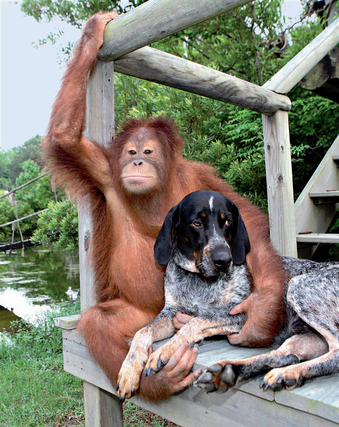
Best buds since the day they met, Suryia and Roscoe enjoy cuddling up with each other.
Chapter 2
Ambassador
SURYIA
Suryia has a special job at the animal preserve. He is one of Doc’s “animal ambassadors” (sounds like am-BASS-uh-ders). The word “ambassador” usually means a person who represents his or her country. Suryia’s job is to represent orangutans that live in the rain forests.
Doc thinks it’s good for people to see Suryia and the other animals at the preserve up close. He wants people to see them in action. He hopes this will make people want to help protect the animals’ relatives in the wild.

Suryia is a great animal ambassador. People just love to watch him. When Suryia and Roscoe are together, they really draw a crowd!
Sometimes the two friends walk in the yard together. Suryia grabs Roscoe’s leash and tugs it. That gets his pal going. They stroll around for a few minutes. Soon Suryia does more than just walk. He grabs his feet and rounds himself into a ball. Over and over he rolls. He falls on Roscoe. Then Roscoe jumps on top of him. Suryia pulls the leash one way. Roscoe tugs it back the other way. There is no such thing as walking in a straight line for these two.
Suryia can have fun with almost anything. For him, an empty box is a fine place to sit. Then he puts the box on his head like a hat. It gets a little ripped. That makes it into a good superhero cape! Soon the box is completely torn open. Now Suryia crawls under it. Does anyone want to play hide-and-seek?
Like all orangutans, Suryia likes to make faces. He pulls his bottom lip out. He puckers his rubbery lips. He makes silly smiles. He sticks out his tongue. He wipes his face down with his hand and plays peek-a-boo. Sometimes he blows pfffffft sounds. That always makes people laugh.
People don’t get tired of watching Suryia. But Suryia does get tired of watching people. He would rather play with Roscoe. He likes to hang out with other orangutans, too.
Lucky Suryia! One of his other jobs is doing exactly that—hanging out with other orangutans. Or really, to let them hang out with him. In the wild, baby orangutans learn about life from their families. At they preserve, they learn from Suryia. They learn by watching and playing with him.
If Suryia lived in the wild, he’d be on his own by now. At the preserve he lives in a house with three younger orangutans. An animal trainer named Moksha Bybee (sounds like MOKE-shuh BYE-bee) lives with them.
Suryia and the three little orangutans love to wrestle. They have fun tickling each other. They run and roll across the yard. Sometimes Suryia grabs a twig to scratch his back. The little ones find their own twigs. They try to scratch their backs. Sometimes Suryia makes kiss-kiss noises at the babies. They make kiss-kiss noises back.
Most of the time Suryia gets along just fine with the little orangutans. But at mealtimes he has to eat by himself. Otherwise, Suryia would grab their food. That’s just what older orangutans do.
In the evening, Moksha gives the orangutans a bath. She puts them in the tub. She tries to wash them. They just want to splash. They want to play. This surprises Moksha. In the wild, orangutans do not like water. In the wild, water means danger. In the tub, water means fun.
Lots of things would be different for Suryia if he lived in the wild. At the preserve, he spends his days with lots of other animals. In the rain forest, he would spend his days alone. He would look for food alone. At night he would make a nest of leaves in a treetop and sleep alone. He would not have a dog as a friend!
At the preserve, Moksha helps the young orangutans get ready for bedtime. She pulls blankets into round, soft nests for them. Suryia makes his blanket nest all by himself.
Before lights out, Moksha does one more thing. She calls, “Roscoe, bedtime!” Roscoe runs into the house. Then he curls up to sleep next to his best friend, Suryia.
Orangutan School
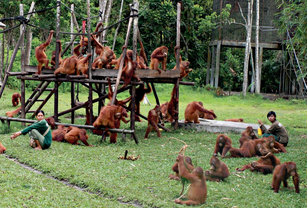
In Sumatra and Borneo, wildlife workers run special schools for young orangutans that don’t have moms. The workers teach them skills they need to survive in the wild.
Wild orangutans live in trees. They can go for weeks without touching the ground. At orangutan school, baby orangutans practice on jungle gyms made of ropes and netting. They learn how to climb up and stay up. If a baby goes too high and gets scared, a worker helps it back down. After a cuddle, it’s time for another try!
Конец ознакомительного фрагмента.
Текст предоставлен ООО «ЛитРес».
Прочитайте эту книгу целиком, купив полную легальную версию на ЛитРес.
Безопасно оплатить книгу можно банковской картой Visa, MasterCard, Maestro, со счета мобильного телефона, с платежного терминала, в салоне МТС или Связной, через PayPal, WebMoney, Яндекс.Деньги, QIWI Кошелек, бонусными картами или другим удобным Вам способом.

